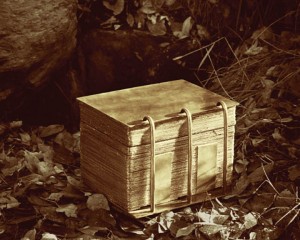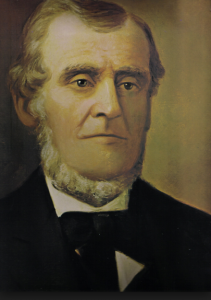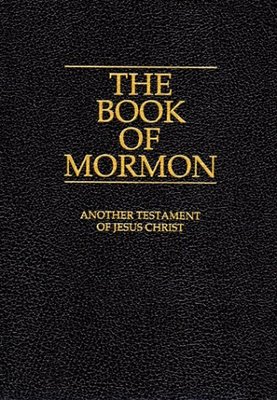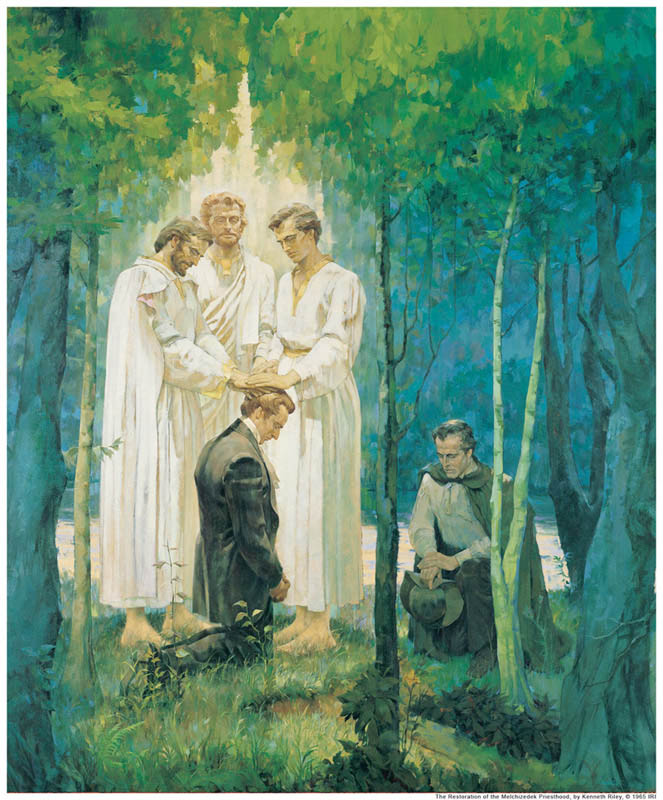The Golden Plates and the Translation of the Records
On September 22, 1827, Joseph Smith and his wife, Emma, borrowed a horse and buggy and went to the Hill Cumorah, where a record engraved on gold plates was buried. Joseph was given the records by the Angel Moroni, a heavenly messenger who had visited and instructed Joseph many times. Joseph was also given the Urim and Thummim by Moroni, which were two stones used by the ancient Israelite prophets for receiving revelations (Exodus 28:30) and were used by Joseph at times to translate the record into English. The plates were each about as thin as rolled tin with characters engraved upon them. Witnesses described them as either gold or gold in appearance. They were connected by three rings and measured about six by six by eight inches thick.
 This ancient record contained the dealings of Jesus Christ with some of the inhabitants of the ancient Americas. It is meant to be a companion book of scripture to the Bible and is a second witness to the world that Jesus is the Christ—the Savior of the World and the Son of God. The Book of Mormon restores several basic doctrines that were lost from the Bible. Two-thirds of the record from which the Book of Mormon was translated was sealed, and Joseph never translated that portion. For the next few months he studied the records through the aid of the Urim and Thummim. He began the work of translation with Emma as his scribe.
This ancient record contained the dealings of Jesus Christ with some of the inhabitants of the ancient Americas. It is meant to be a companion book of scripture to the Bible and is a second witness to the world that Jesus is the Christ—the Savior of the World and the Son of God. The Book of Mormon restores several basic doctrines that were lost from the Bible. Two-thirds of the record from which the Book of Mormon was translated was sealed, and Joseph never translated that portion. For the next few months he studied the records through the aid of the Urim and Thummim. He began the work of translation with Emma as his scribe.
News that Joseph had records inscribed on metal plates with the appearance of gold spread through the surrounding community, and many people attempted to get the plates from Joseph. Joseph was attacked several times and even shot at. Hyrum Smith, Joseph’s brother, made a wooden box in which to hide the plates and which could in turn be hidden under a loose stone in the fireplace or in barrels used for storing foodstuffs. Joseph was forced to move several times during the translation process.
Early on, a local farmer named Martin Harris (who was much older than Joseph and who was well respected in the community) became interested in the record and helped Joseph as scribe during the early translation. Martin was curious, but also skeptical. Joseph Smith needed to find supporters, and so sought to convince Harris that the work was genuine. At length, Joseph copied some of the characters from the plates onto a piece of paper along with his initial translation. Harris went to Albany and New York City to show the characters and translation to various scholars hoping to confirm that the work was accurate.
Harris visited Charles Anthon at Columbia College (now University), to whom he showed the characters. The later accounts of Anthon and Harris do conflict somewhat, Harris asserting that Anthon confirmed the antiquity of the characters and the accuracy of the translation, while Anthon later claimed that he did not, but instead asked to see the book. When Harris replied that he could not bring the record because it was sealed, and after he told Anthon that an Angel of God had shown Joseph where the record was buried, Anthon rejected the whole affair and declared, “I cannot read a sealed book.” Whatever exactly happened, Harris became convinced of the truthfulness of the work Joseph Smith was undertaking and was even willing to support Joseph financially until the work was completed. Those who believe Joseph Smith was truly a prophet of God recognized this event as fulfillment of the prophecy made in Isaiah 29, where a book is delivered to the learned man who is unable to read it, and then given to an unlearned man who, by the power of God, can read it.
Loss of the 116 Pages
Harris’ wife, Lucy, however, needed more convincing. She became angry over the time Martin spent with Joseph and Martin’s willingness to give Joseph money when he needed it. In the summer of 1828, after translating 116 handwritten pages, Martin begged Joseph to let him show the translation to his wife so that she would know he was really working on something worthwhile. Joseph prayed to the Lord about it and received from the Lord a definite no, but Martin was insistent. Twice more Joseph prayed to the Lord to let Martin borrow the writings. Finally, upon Joseph’s third request, the Lord said yes, but only if Martin swore an oath to show them only to a few designated persons. Martin agreed, and Joseph gave him the writings.
 A short time after Martin Harris left for his home in Palmyra, Joseph’s wife Emma gave birth to a son, whom they named after Joseph’s deceased older brother, Alvin. Baby Alvin died the day he was born, and Emma became so ill, that it appeared she would die also. For nearly two weeks, Joseph sat at her bedside, rarely sleeping or eating. Once she improved slightly, his attention ventured to the 116 pages of manuscript. Martin had been gone for three weeks, and Joseph had heard nothing from him.
A short time after Martin Harris left for his home in Palmyra, Joseph’s wife Emma gave birth to a son, whom they named after Joseph’s deceased older brother, Alvin. Baby Alvin died the day he was born, and Emma became so ill, that it appeared she would die also. For nearly two weeks, Joseph sat at her bedside, rarely sleeping or eating. Once she improved slightly, his attention ventured to the 116 pages of manuscript. Martin had been gone for three weeks, and Joseph had heard nothing from him.
Emma encouraged Joseph to go to Palmyra, and Joseph left her in the care of his mother Lucy. Out of anxiety for the safety of the manuscript, Joseph took a stagecoach from Harmony, Pennsylvania, without eating or sleeping. He then walked another twenty miles through the night. Joseph arrived at the home of his parents in Manchester, New York, and sent for Martin, preparing breakfast for him in expectation of Martin’s quick response.
Martin arrived hours later than expected. He had lost the writings, now known among members of The Church of Jesus Christ of Latter-day Saints (often called “Mormons”) as the lost 116 pages. Martin had broken his oath and showed the writings to many other interested persons and eventually lost track of them. Joseph was devastated. In a subsequent revelation given to Joseph Smith, the Lord rebuked him for not accepting the Lord’s original response to his request, and for fearing men above God. For a time, the plates and the Urim and Thummim were taken away from Joseph. Joseph later said that this was one of the worst periods in his life.
When the plates were entrusted to Joseph once more, Joseph was commanded not to translate those passages already translated and lost. The Lord revealed that those who had stolen the writings were planning to alter them and publish them when Joseph retranslated the record, thus attempting to prove that he could not translate, or that the work was a fraud. Instead, the Lord told Joseph to go forward and translate the record from where he had left off, because it contained a summary of those 116 pages elsewhere in the ancient text.
The Arrival of Oliver Cowdery
Shortly after this episode, a school teacher named Oliver Cowdery came to work in the Palmyra area and heard about Joseph Smith, whom the locals disparagingly called “Joe Smith” or “Peepstone Joe,” and his “Gold Bible,” as the locals referred to it. Curious, Oliver visited Joseph’s house and talked to Hyrum, Joseph’s older brother. Joseph Smith and Emma were at the time living with her family in southern New York, where they had fled to obtain relief from persecution and harassment. In April of 1829, Oliver traveled to visit them. He found them living in Harmony, Pennsylvania.
Very quickly after meeting with Joseph Smith and Emma, Oliver became convinced that the work was true and became Joseph’s primary scribe and very good friend. Oliver was the primary scribe for the handwritten draft of the Book of Mormon, as the record on the golden plates was to be called. From April 7 to the last week of June, 1829, Joseph dictated and Oliver wrote. In sixty working days, after subtracting days they spent traveling and doing other work, they translated virtually all of what is now the Book of Mormon, a work of more than 500 pages. This is an astonishing feat for any translator.
The Witnesses to the Book of Mormon
One of Joseph Smith’s burdens during this period had been to carry on the translation alone, though several different scribes assisted. At the direction of heaven, Joseph alone was permitted to see and handle the plates, unless God directed otherwise. Finally Joseph was permitted to share his burden as he translated a passage in Ether 5:3 which states:
And in the mouth of three witnesses shall these things [the teachings of the Book of Mormon] be established; and the testimony of three, and this work, in the which shall be shown forth the power of God and also his word, of which the Father, and the Son, and the Holy Ghost bear record—and all this shall stand as a testimony against the world at the last day.
 Three men were selected to be these special witnesses of the Book of Mormon: Oliver Cowdery, Martin Harris, and David Whitmer, who had also served as scribe. Joseph and these men retired to some woods around Fayette and prayed in turn for a manifestation from God. After some time, Harris withdrew, feeling that he was to blame for the lack of a heavenly vision. After he left, an angel appeared to the three remaining men and showed them the plates, the Urim and Thummim, and other artifacts. The men reported hearing the voice of God commanding them to testify to the world that these things were true. They were permitted to see, touch, and lift the plates. After the vision closed, Joseph found Martin Harris alone in the woods praying. The two of them continued praying and at last the angel reappeared and Harris saw the same things. Their testimony is affixed to the beginning of every copy of the Book of Mormon as the Testimony of Three Witnesses.
Three men were selected to be these special witnesses of the Book of Mormon: Oliver Cowdery, Martin Harris, and David Whitmer, who had also served as scribe. Joseph and these men retired to some woods around Fayette and prayed in turn for a manifestation from God. After some time, Harris withdrew, feeling that he was to blame for the lack of a heavenly vision. After he left, an angel appeared to the three remaining men and showed them the plates, the Urim and Thummim, and other artifacts. The men reported hearing the voice of God commanding them to testify to the world that these things were true. They were permitted to see, touch, and lift the plates. After the vision closed, Joseph found Martin Harris alone in the woods praying. The two of them continued praying and at last the angel reappeared and Harris saw the same things. Their testimony is affixed to the beginning of every copy of the Book of Mormon as the Testimony of Three Witnesses.
A short time later, Joseph was permitted to show the plates to eight other men: Christian Whitmer, Jacob Whitmer, Peter Whitmer, Jr., John Whitmer, Hiram Page, Joseph Smith, Sr., Hyrum Smith, and Samuel Smith. Their testimony is known as the Testimony of Eight Witnesses. None of these eleven men ever denied this testimony even though they endured severe hardships and were even threatened with death. Although some later left The Church of Jesus Christ (often misnamed the “Mormon Church”) because of unrelated disagreements, they never denied their testimonies about the Book of Mormon. Of the eleven, seven died in full fellowship with the Mormon Church and the remaining four—David Whitmer, John Whitmer, Jacob Whitmer, and Hiram Page—continued to affirm that the Book of Mormon was true even though personal disagreements and conflicts led them out of the Church. Joseph Smith felt greatly relieved to have others to help him share the burden of witnessing of the truth of the work in which he had been called to engage. After the translation was completed, Joseph Smith returned the gold plates to the angel Moroni, until the time should come that the rest of the record should be translated.
The Restoration of the Priesthood
The translation of the Book of Mormon was only interrupted a few times, when Joseph Smith and Oliver Cowdery would retire to the woods to pray about doctrines they discovered in the Book of Mormon. Many modern revelations were given to Joseph in response to questions about doctrine, either in the Book of Mormon, the Holy Bible, or general questions he had. Many of these revelations are recorded today in the Doctrine and Covenants.
Sometime later, in June (the precise date was not recorded), while they were in the woods again, Joseph and Oliver were privileged to see Peter, James, and John, the Lord Jesus Christ’s disciples. These three men gave Joseph and Oliver the higher authority, called the Melchizedek Priesthood, which included the authority to give the gift of the Holy Ghost and to preside over Christ’s Church. The concept of authority and priesthood became a basic Mormon belief. Also in June, on the 11th, Joseph Smith traveled to Colesville, New York, where he obtained a copyright for the Book of Mormon. The translation was finished in Fayette, New York, in late June at the home of Peter Whitmer.
Publishing the Book of Mormon
 Having obtained a copyright in June of 1829, Joseph Smith then sought to publish the Book of Mormon. E. B. Grandin, a publisher in Palmyra, New York, agreed to publish the book, but only if $3,000 dollars could be raised as an advance, given the risky nature of the venture. Martin Harris mortgaged his farm to raise the $3,000 dollars. Joseph further insisted that Grandin never be allowed to have the entire manuscript in his possession. A handwritten copy was made and each day several handwritten sheets were taken to the publisher where he set the type and printed the pages. At the end of the day, the sheets were returned to Joseph.
Having obtained a copyright in June of 1829, Joseph Smith then sought to publish the Book of Mormon. E. B. Grandin, a publisher in Palmyra, New York, agreed to publish the book, but only if $3,000 dollars could be raised as an advance, given the risky nature of the venture. Martin Harris mortgaged his farm to raise the $3,000 dollars. Joseph further insisted that Grandin never be allowed to have the entire manuscript in his possession. A handwritten copy was made and each day several handwritten sheets were taken to the publisher where he set the type and printed the pages. At the end of the day, the sheets were returned to Joseph.
News of the forthcoming publication excited the local press and even made it into major newspapers in New York City. A local journalist named Abner Cole, writing under the pseudonym Obadiah Dogberry, stole some printed pages of the Book of Mormon and published them illegally in his newspaper along with mocking commentary. Joseph, who had the sole publishing rights, threatened legal action, and the writer ceased.
In late March of 1830, the first copies of the Book of Mormon were published, and the first official missionary work began, as Joseph Smith instructed his brother, Samuel Harrison Smith, to take several copies of the book and to begin to share its message. He did so, and had some moderate success in distributing copies, but returned shortly for an important event.
Organization of the Church
Shortly after the Book of Mormon was published, Joseph Smith announced that a church needed to be established. This occurred in two meetings—one held in Manchester, New York, and the other, a more public meeting, at Fayette. The Church of Christ, as The Church of Jesus Christ of Latter-day Saints was originally called, was organized on April 6, 1830. More than 40 people were present, but only 6 put their names to paper to meet the legal minimum requirement to organize a new church. Joseph Smith and Oliver Cowdery were accepted as teachers and elders of the Church. Many others were baptized in that first meeting, including Joseph’s father and mother, and his childhood friend Orrin Porter Rockwell. Around this same time, Joseph Smith cast an evil spirit out of Newel Knight, an early convert.
Joseph immediately sent more missionaries out into the surrounding regions and found success in Fayette and Colesville, but a few converts came from Palmyra. Elders, priests, and teachers were ordained in the congregations, but, from the beginning, Mormonism had a lay clergy, meaning those who serve are not compensated monetarily for their time. All service is on a volunteer basis. This continues today. Virtually every male was ordained to the priesthood and appointed to some leadership function. Most of the early converts came from members’ extended families, as cousins, uncles, and others were baptized and formed branches of the Church in their own towns.
Joseph Smith was arrested for stirring up the community by preaching the teachings of the Book of Mormon and for organizing public meetings. Joseph was acquitted, but vigilante mobs continued to plague the Mormons at their meetings and at their baptisms. This persecution never ceased to plague Joseph during his life. He was arrested on false accusation many times. The building up of the Church continued, however, and Mormon missionaries were sent throughout Canada and New England. By revelation (see Doctrine and Covenants 25), Joseph appointed Emma, his wife, to organize a hymn book for the young “Mormon Church.” Joseph continued to organize the Church structurally. When new converts claimed to have revelations for the whole Church, Joseph reminded them that only one person, he, was appointed to receive revelations for the Church as a whole, but that anyone could receive personal visions and revelations for themselves and their families. Hiram Page was one who received supposed church-wide revelations, but after counseling from Joseph he conceded that they were not from God (see Doctrine and Covenants 28).
In the fall of 1830, Joseph Smith received a revelation that missionaries were to preach to the Native Americans in Missouri, whom the Mormons referred to as the Lamanites (after a tribe in the Book of Mormon), and to preach along the way. The Mission to the Lamanites, as it was called, sent Peter Whitmer, Parley Pratt, and Ziba Peterson westwards. Parley Pratt, a recent convert from Ohio, had previously been an itinerant preacher for the Campbellites, and as the group journeyed to Missouri, they preached to a Campbellite congregation in Kirtland, Ohio, overseen by an old friend of Pratt’s named Sidney Rigdon. Rigdon, an educated and eloquent minister, soon joined the Church, and so did hundreds of the Campbellites. This caused enough of a problem that Alexander Campbell, the leader of the Campbellites (which group was later called Disciples of Christ), was forced to respond to the growing number of converts from his ranks by publishing the first books and pamphlets attacking the Mormons.
The Mormons, and Joseph Smith especially, continued to suffer legal harassment and mob disruption of meetings in New York. Joseph was arrested numerous times, because his preaching disturbed the peace. As Joseph prayed to God for guidance in assisting the persecuted Saints, he received a revelation instructing the members to gather to Kirtland, Ohio, where the “Law of the Lord” for the Church would be given. Joseph and his family moved once again in January 1831, and resettled in Kirtland, where hundreds of converts awaited him. By the summer of 1831, most of the faithful Mormons remaining in New York followed suit.
Additional Resources:
Read more about the restoration of the priesthood


 Watch a video about the restoration of the gospel on lds.org
Watch a video about the restoration of the gospel on lds.org